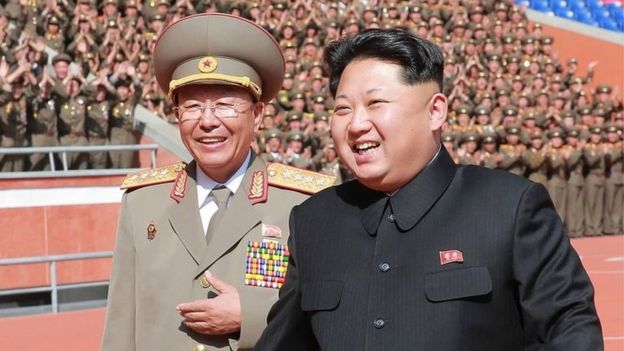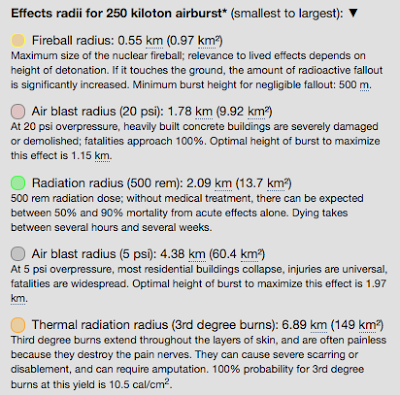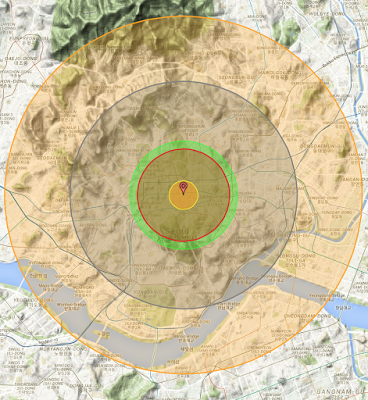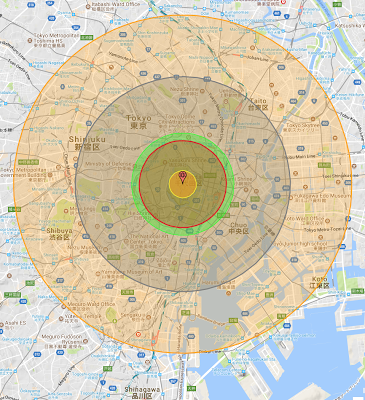
While North Korea has faded somewhat from global news coverage, a recent analysis by the U.S. – Korea Institute at Johns Hopkins SAIS otherwise known as 38 North takes a sobering look at what would happen during a nuclear attack on both Seoul and Tokyo, two of the world’s most populous urban areas. Having spent some time in Tokyo, the density of humanity in the world’s largest urban area is rather stunning particularly given that its population is roughly the same as Canada’s.
While most of North Korea’s thermonuclear warhead tests have been modest by Cold War standards, falling in the range of 1 to 10 kilotons, the test of September 3, 2017 was a game changer. Analysis by experts suggests that North Korea now has the expertise to arm ballistic missiles with nuclear warheads and has an arsenal of between 20 to 25 warheads with yields in the 15 to 25 kiloton range. According to an analysis by 38 North, the yield approached 250 kilotons, roughly 10 times the yield of the Fat Man weapon that destroyed Nagasaki in 1945 and by far the nation’s largest yield ever. This suggests that the North could eventually upgrade its nuclear arsenal significantly.
The analysis by 38 North assumes the following:
1.) North Korea has 25 operational nuclear weapons.
2.) The yield of these nuclear weapons ranges from 15 to 250 kilotons.
3.) North Korea launches its entire nuclear arsenal against both Seoul (195 kilometres from Pyongyang) and Tokyo (1284 kilometres from Pyongyang).
4.) The weapons are timed for airburst detonation, the most efficient way to destroy infrastructure and kill civilians.
The population of Seoul/Inchon is 24,105,000 with a density of 8800 persons per square kilometre and the population of Tokyo/Yokohama is 37,900,000 with a density of 4440 persons per square kilometre. By way of comparison, the population of the New York – Newark – Jersey City is 20,153,634 with a population density of 939 persons per square kilometre. The population density varies widely across both metropolitan areas, reaching 17,002 per square kilometre in Seoul Special City and 14,950 in Tokyo’s Special Wards.
Assuming that the North Koreans were to launch a single successful 250 kiloton thermonuclear device and detonate it over the centres of both cities, it is estimated that the following casualties would occur:
1.) Seoul:
Fatalities – 783,197
Injuries – 2,778,009
Using the following guide:
…from Alex Wellerstein’s Nukemap website, here is the area of damage from a single 250 kiloton blast over central Seoul:
2.) Tokyo:
Fatalities – 697,665
Injuries – 2,474,627
From Alex Wallerstein’s Nukemap website here is the area of damage from a 250 kiloton airblast over Chiyoda, the area where the Imperial Palace is located in Tokyo:
According to the analysis by 38 North, total casualties for both cities in the event of a single 250 kiloton airburst is estimated to be 6,733,498.
Let’s look at another set of scenarios. North Korea launches all 25 of its nuclear missile warheads with the probability of detonation ranging from 20 percent to 80 percent, a reasonable range given that the THAAD defense system has been installed in South Korea and the Aegis Ashore Antiballistic Missile system is being installed in Japan. Here are the estimates of casualties using 15 kiloton (the smallest likely) and 108 kiloton (the smallest likely yield of the most recent test) weapons:
1.) Seoul:
i.) 15 kiloton – 20 percent detonation – 1,016,845 casualties
ii.) 15 kiloton – 50 percent detonation – 2,452,122 casualties
iii.) 15 kiloton – 80 percent detonation – 4,067,379 casualties
iv.) 108 kiloton – 20 percent detonation – 3,795,891 casualties
v.) 108 kiloton – 50 percent detonation – 6,288,312 casualties
vi.) 108 kiloton – 80 percent detonation – 7,686,364 casualties
2.) Tokyo:
i.) 15 kiloton – 20 percent detonation – 917,997 casualties
ii.) 15 kiloton – 50 percent detonation – 2,294,991 casualties
iii.) 15 kiloton – 80 percent detonation – 3,671,986 casualties
iv.) 108 kiloton – 20 percent detonation – 2,273,087 casualties
v.) 108 kiloton – 50 percent detonation – 5,644,584 casualties
vi.) 108 kiloton – 80 percent detonation – 6,867,557 casualties
As you can see from these estimates, if even a handful of 15 kiloton thermonuclear devices detonate over either of the world’s most populous urban areas, cities which happen to lie within range of North Korea’s current ballistic missile inventory, the number of casualties would be stunning. Our only hope is that saner heads prevail and that both Donald Trump and Kim Jong-un back down from their posturing.
Click HERE to view more.
You can publish this article on your website as long as you provide a link back to this page.




Kim Jong Un has to be taken out, as he cannot be allowed to have Nukes and Missiles, which he would sell to every dictator. The US should use non-nuclear bombing as first choice, and EMP only as a back-up. Let China appoint their puppet to run North Korea. No Military to remain in either the North or South, once things have settled down and China has firm control of North Korea. Do this NOW, before Kim’s nukes and missiles get more refined and numerous.